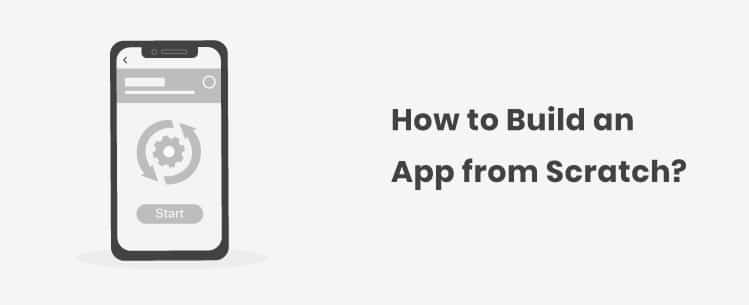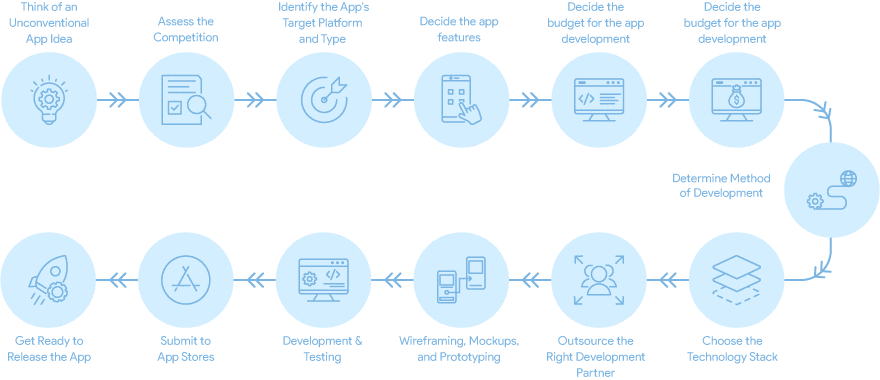
Quick Summary:
Building an app from scratch can be daunting, especially for those new to app development. However, anyone can create a successful and functional app with guidance and a clear understanding of the process.
The app development process requires careful planning and execution; therefore, we prepared a guide to assist you with building an app from scratch.The blog post provides a step-by-step guide for building an app from scratch, covering everything from conceptualization to launch.

Build an app from scratch: Detailed process
How do I create an app step-by-step? Follow the given steps to develop a successful app.
Step 1: Think of an Unconventional App Idea
Stop wondering how to build an app from scratch; focus on your creative nerves and develop a unique idea. The idea is power!
A unique idea that solves your user’s problems will surely put you in a win-win situation. You can expect the highest profits from the most relevant and value-creating apps. So, the first step in creating an app from scratch is developing a novel, timely, and feasible idea.
Ponder on these three questions-
- What are your business needs and future expectations from the app idea?
- What do your customers demand currently?
- Does your app idea align with the above two?
If the answer is yes, you can proceed with the app idea. Your app idea requires a QA analysis though before its final launch. Put the original statement through rigorous testing of novelty. It also requires some research on your peers and the current market trends.
a) Market research
Market research involves surveys and studies of the app’s potential, scope, feasibility, future popularity, and prospects on social media, internet forums, etc. The research gathers responses from your target audience from the web and social media.
b) Predicting and Analyzing Reactions from an Audience
It involves gathering responses from the audience on the proposed idea. This is a good way to proceed as it minimizes the chances of risk. You can connect with your target audience on social media and research sites to understand their feelings about your proposed app.
On the other hand, you can also ask them about their favorite apps and the features they like the most. Also, remember to inquire about the need for improvements they see in their favorite apps.
Step 2: Assess the Competition
Know your competition inside and out if you’re serious about breaking into the app industry. Knowing your competition’s strengths and weaknesses is essential for success. That’s why you need to check out what other similar applications are doing to stay competitive in building an app from scratch.
Create a catalog of similar apps: Go ahead and do some serious digging with the keywords to uncover all the applications that are competing with you.
Conduct a Market Analysis for Each App: A market analysis is essential in developing a successful mobile app. You can learn about an app’s online tactics by analyzing its website using a marketing tool, such as its keywords.
Understand your competitors’ web presence: Examine the Competition’s Online Presence. Using services like Alexa and Quantcast, you can assess how well your rivals’ sites perform and where they stand in the market. Doing so will provide your insight into the kind of people who visit their site and how successful their marketing strategy is.
Step 3: Identify the App’s Target Platform and Type
The next step in the custom app development process is to decide the app type. Whether you’re building a native app for iOS and Android, a hybrid app that works on all platforms, a web app hosted in the cloud, or a cross-platform app that uses each platform’s best features.
Step 4: Decide the app features
The next step toward building an app from scratch is to decide on the most critical aspects of your app- app features. Make an informed choice in picking the features for your app.
Here is what you can do: Think about the primary purpose that the app intends to serve. Since every software is released for a specific reason, its features should reflect that goal. Inquire about the motivations for releasing this software to the public. This method may help you learn the essential characteristics of your app. To provide a truly native experience, you must also be familiar with the platform-specific capabilities.
Essentials First
Minimize the risk and release the software with the essential features to play safely. Once the software is out, the feedback from your target audience will guide you on what needs to be added in future releases. So, choose the most relevant features for the first release.
Features Taking Technical Limitations into Account: You don’t want any technical limitations to hinder the performance of your software. So, back it up with features that can handle these technical limitations. For instance, offline access is helpful if your intended audience resides in places with poor internet availability.
Step 5: Decide the budget for the app development.
One of the first things to do when researching how to build an app from scratch is to create a budget that covers the costs of planning, designing, and developing the app from start to finish.
Several factors affect the amount of money needed to create an app. Mobile game development costs and time commitments will vary significantly from those of a financial technology app.
Step 6: Decide the budget for the app development.
One of the first things to do when researching how to build an app from scratch is to create enough budget to cover the costs of planning, designing, and developing the app from start to finish. Several factors affect how much money is needed to create an app. For instance, the cost of developing a gaming app will vary from a fintech app.
Step 7: Determine Method of Development
Do you want to learn how to make an app without spending a dime? So, make sure you’re using the proper approach to development.
The key to effective project management is picking the correct development approach. We follow an agile development approach to develop and deliver custom software applications on time.
Step 8: Choose the Technology Stack
Building two native applications for iOS and Android requires using the platforms’ native technology stacks and development tools. If you’re creating a hybrid project, a web development stack will generally do the trick.
Modern cross-platform frameworks allow the building of natively compiled applications. Again, the choice of framework depends on your app requirements and budget.
Step 9: Outsource the Right Development Partner
The most crucial step in building software from scratch is hiring a reliable development team. The success of your app project depends on the custom software development team you hire. Choose a team of skilled app developers with a proven track record in creating custom applications. While choosing the offshore software development agency, prioritize your app quality and business goals rather than the cost. Outsourcing software development services from countries like India can help get quality services under a limited budget.
Step 10: Wireframing, Mockups, and Prototyping
Now that you know the development platform, technology stack, and team to choose, what’s next? The next step is to design the interfaces of your software. A good interface design will grab your user’s attention. The app’s design process includes wireframing, mockup design, and prototype.
The purpose of a wireframe is to visually represent the overall layout of the app. The app design process continues from these rough drawings of the app screens to more detailed mockups, buttons, images and interactive prototypes that look like the final app design.
Step11: Development & Testing
The actual development phase comes when the team brings the entire process together to turn your app ideas tangible.
The next step is to test the application thoroughly for performance, user experience, functionalities, and other technical issues. Specific tests are performed concurrently with product design and development, while others are performed after development or just before a product is launched.
We use the continuous testing strategy, which involves testing each completed function or unit as developed. App designers also use A/B testing to gauge the efficacy of various design iterations in light of the app’s intended purpose.
Step 12: Submit to App Stores
The next step is putting the apps on Google Play and the Apple Stores. Both stores, of course, have their requirements for submitting apps. You must follow and meet the required terms and conditions to submit the apps, and your outsourcing software development agency can help you with the same.
Step 13: Get Ready to Release the App
Making an app visible to the eyes of prospective customers has become more difficult as the app industry has become increasingly competitive. With hundreds of competitors in every app category, it’s tough for a new app to stand out from the crowd and be noticed by its intended users. For this reason, it is not enough to know how to construct a simple mobile app; you also need to concentrate on marketing strategies that make the app more easily discoverable.
An essential part of every app’s marketing plan is timing the app’s release with a pre-launch campaign. The intended users should hear about the app and start using it as soon as it hits the market. Because of this, it’s crucial to create a large splash with the debut and conducting an effective pre-launch promotion is crucial.
Conclusion
We have covered every angle of how to build your app from scratch. So, what’s next?
It is time to build your mobile app and make it stand out among millions of already available apps. And that’s challenging. However, proper execution of each step of the development process, along with innovation, can do wonders. If it’s executed well, even a mediocre concept may triumph.
At Valuetree, we create world-class products and app solutions, pushing our limits beyond conventional approaches. Call us at +1 (312) 380-0911 or email on sales@valuetree.io to book a free consultation.
